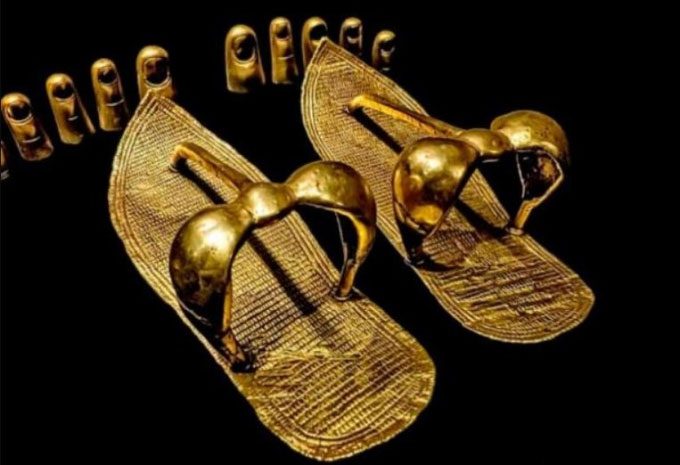Not only made from precious materials like leather and gold, the sandals found in the tomb of King Tutankhamun were also designed to aid his mobility.
The tomb KV62 of King Tutankhamun, one of the most fascinating discoveries by Egyptologists, garnered global attention in the 1920s. While the golden mask of King Tutankhamun has become a symbol of ancient Egypt, it wasn’t until 2007 that experts began in-depth studies of his sandals, according to Ancient Origins.

A pair of sandals with gold straps and toe caps in the tomb of King Tut. (Photo: Mary Harrsch)
While the exact number of sandals has not been determined, at least 80 specimens were discovered in the intact tomb of King Tut, intended to accompany him to the afterlife. Some sandals are well-preserved, while others remain only fragments of straps. The best-preserved pair is the golden sandals found on the feet of King Tutankhamun’s mummy.
Andre Veldmeijer, a Dutch archaeologist, conducted research on 81 specimens stored at the Luxor Museum and the Egyptian Museum in Cairo. All of them are burial sandals from King Tutankhamun’s tomb, including stitched sandals adorned with beads made from gold, birch bark, plant fibers, gemstones, leather, and gold.
DNA testing and CT scans of the mummy revealed that King Tutankhamun may have suffered from congenital disabilities due to inbreeding, including a clubfoot and foot deformities, which caused him to walk with a limp and rely on a cane. Among the collection of sandals found in the tomb, three pairs feature horizontal straps to assist with mobility.
The research team was further surprised to find illustrations of enemies depicted on many of King Tutankhamun’s sandals. Although experts are unsure whether these sandals were intended for walking or held symbolic significance, one sandal’s insole features an African prisoner on one side and an Asian prisoner on the other, representing the enemies of King Tutankhamun. This design implies that every step the pharaoh took, he was treading upon his foes.


















































